- NLI Research Institute >
- Revised Economic Forecast for Fiscal 1997 -Weak First Half Limits Growth to 1.4%-
Revised Economic Forecast for Fiscal 1997 -Weak First Half Limits Growth to 1.4%-
the Economic Research Dept.
Font size
- S
- M
- L
Despite gaining strength, Japan's economy cannot avoid a standstill in the first half of fiscal 1997 due to increased burdens including tax increases. However, the economy will manage to avoid losing momentum and resume growth in the second half on the strength of capital investment and external demand. What follows is a revision of our fiscal 1997 forecast issued December 12, 1996.
1. The Domestic Economy - Higher Tax Burden on Households to Cause Sluggish First Half
The economy has shrugged off its sluggishness from the spring to summer of 1996. We predict that the sustained recovery during fiscal 1996 will put real GDP growth at 2.7% for the year.
In fiscal 1997, tax increases and other factors will make a standstill inevitable in the first half, pulling down the real growth rate to 1.4% for the year. However, the economy will avoid losing momentum on the strength of improving external demand and continued capital investment growth, and resume a steady recovery in the second half of the year.
(1) Present Economic Conditions
The correction of the strong yen has helped external demand to turn positive mainly due to a moderate recovery in automobile exports, while capital investment is improving centered around information technology. The economic recovery is presently gaining strength, as private sector demand and external demand are more than offsetting the decline in public works investment.
In addition, the January-March 1997 quarter saw a last-minute consumption surge ahead of the consumption tax increase, which has apparently pushed up private consumption. Automobile sales increased by 100,000 units due to: (1) the introduction of new models, and (2) the last-minute demand rush ahead of the consumption tax hike. The last-minute demand for automobiles may be offset by a reactive decline in the April-June quarter. However, the increased demand due to new car models will moderate the decline in the April-June quarter.
Increased sales of automobiles as well as sundries, furniture and electrical appliances are estimated to have increased private sector consumption by almost 1% in the January-March quarter.
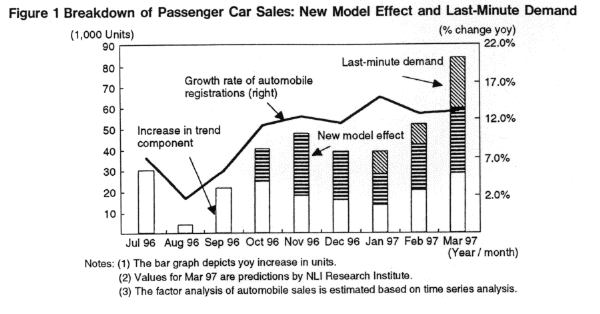
(2) Japan's Economy in FY 1997
The economy will come to a standstill in the first half of fiscal 1997, but will pick up speed in the second half. The impact of the increased burden on households from tax increases and health insurance reforms will be concentrated in the first half, while the following cyclical factors will contribute in the second half: (1) sustained improvement in external demand, (2) sustained growth in capital investment, and (3) consumption propped up by moderate improvement in the employment environment. We predict that real GDP will grow 1.4% (previous forecast: 1.0%).
1) Assumptions of the Forecast
- Public spending: average level, with no moving forward of future spending
- Exchange rate (annual average): ¥114
- Crude oil price (customs clearance): $19/ barrel
- Official discount rate: a 0.5% hike in the January-March quarter of 1998
2) Key Points of the Forecast
Amid the declining public sector demand, the stagnation in the first half of fiscal 1997 will be caused primarily by a decline in consumer spending as tax increases and health insurance reforms increase the burden on households.
Our revised forecast takes into account: (1) the implementation of health insurance reforms, which will reduce the GDP growth rate by 0.1%; and (2) the weaker yen, which has dropped ¥9 against the dollar since the previous forecast and will reduce the GDP growth rate by 0.2%. Whether the economy will resume its recovery in the second half of fiscal 1997 will rest on the sustainability of private sector demand (especially consumption and capital investment), and on external demand as the yen remains weak.
Effect of Higher Burdens on Households
Increased burdens on households are expected to dampen consumption primarily in the first half of fiscal 1997. Nominal disposable income growth will be restricted by: (1) the abolition of the special income tax cut (approximately ¥2 trillion), (2) implementation of health insurance reforms presently under debate (approximately ¥0.9 trillion), and (3) higher public welfare pension rates implemented last October (approximately ¥0.3 trillion). Moreover, real disposable income growth will be hindered by a fourth factor: higher prices caused by the consumption tax hike (approximately ¥5 trillion).
However, the employment environment is improving, as seen by the increase in job openings among sectors where corporate restructuring has made progress. Thus we predict that consumption will improve moderately from the second half as households begin to adjust to the higher burdens.
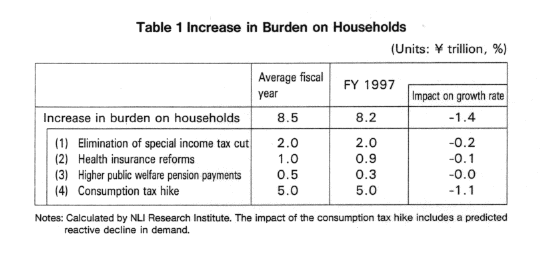
Capital Investment
Capital investment in fiscal 1996 appears to have grown over the previous year. Despite lower semiconductor related investment, capital investment has been driven independently by communications and other sectors. In addition, investment demand have been spreading beyond large manufacturers to non-manufacturing sectors.
For fiscal 1997, favorable conditions including progress in capital stock adjustment suggest that capital investment will continue to grow. The diffusion index for production facilities indicates that the sense of excessive investment has generally declined to initial levels of past investment expansion phases. In addition, returns on investment are improving against a backdrop of low interest rates. In terms of the business cycle, conditions are favorable for capital investment to continue expanding from the previous year.
However, a number of surveys have reported that initial investment plans for fiscal 1997 are generally flat from the previous year due to a leveling off of communications related investment. Although a lull in independent investment will cause capital investment growth to decline from the previous year, we expect growth will be maintained as improving business conditions prompt upward revisions of investment plans.
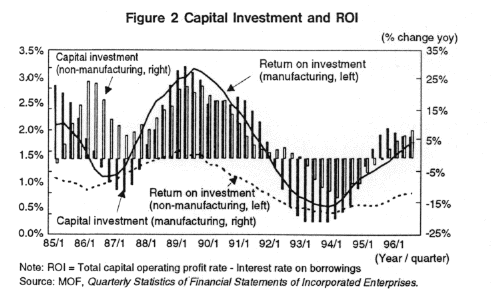
Effect of the Weak Yen
With the cumulative effect of the strong yen playing out and the yen weakening, real exports of goods and services have been expanding after bottoming out in the January-March 1996 quarter, while imports have been sluggish. As a result, the contribution of external demand turned positive for the first time since the July-September 1996 quarter, five quarters ago.
In the future, against the backdrop of a weak yen, exports and imports will maintain their present undertones and the current account surplus will gradually increase. Despite pressure from the rising surplus to correct the weak yen in the second half, the contribution of external demand for fiscal 1997 will turn positive at 0.4%, up from -0.4% in fiscal 1996.
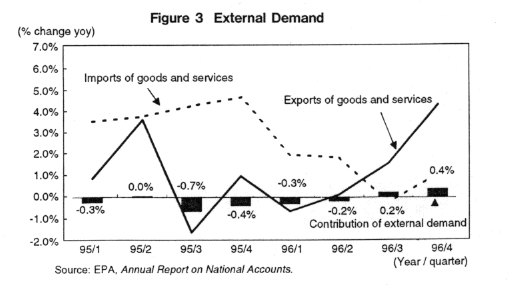
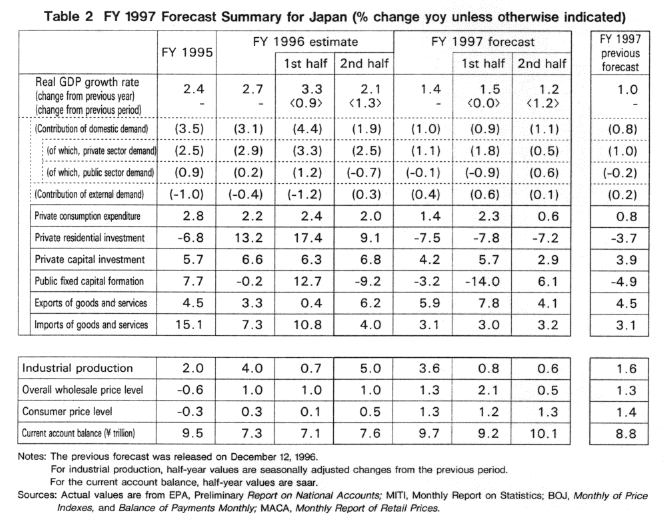
2. Monetary Policy
−Interest Rate Hike Expected in Second Half of FY 1997 or Later
(1) High Long-term Bond Prices Sustained by Good Supply and Demand
Recently released GDP and industrial production statistics for the October-December 1996 quarter clearly indicate that the economy is recovering.
However, long-term bond prices continue to be high due to the prevailing concerns that the economy may slow down in the April-June quarter and the very-low interest rate policy will persist, combined with good supply and demand. As for short-term interest rates, the unsecured overnight call rate temporarily exceeded 0.5% due to strong demand for short-term financing, but overall the BoJ has managed to hold interest rates down.
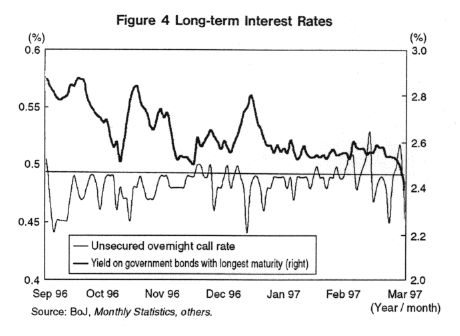
(2) Interest Rates to Rise Moderately in FY 1997
Judging from the weakness of the recovery, tightening of fiscal policy, ongoing liquidation of non-performing loans, and price stability, we expect the present very-low interest rate policy to be maintained for the time being. The timing of an interest rate hike will occur no earlier than the second half of fiscal 1997, after the deflationary effects of the consumption tax hike and other factors have abated. We expect the official discount rate to be increased from 0.5% to 1.0% in the January-March 1998 quarter. Long-term market rates should also rise gradually from the second half.
The NLI Research interest rate leading indexes have not as yet pointed to any monetary policy changes. While Index II was positive at 1.3 in January 1997, Index I stood at 50.0% in December 1996 and 57.1% (estimate) in January 1997. (To signal an interest rate hike, Index I must be at least 80% for three consecutive months, while Index II remains positive.)
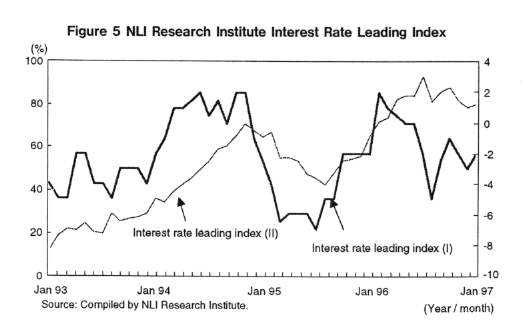
Money supply growth has remained in the 3% range (yoy change) since last fall. When seasonal and temporary factors are excluded, the trend and cyclical components clearly indicate a slowdown recently. The money supply growth rate will decline in the first half of fiscal 1997 as the economy comes to a standstill, then increase as the economy resumes a moderate recovery.
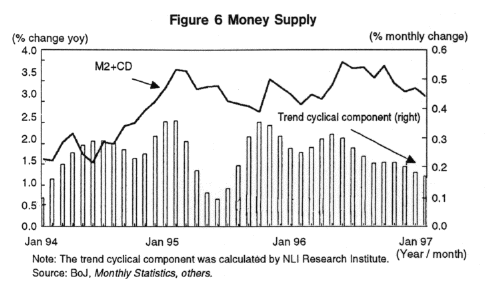
3. Overseas Economies
(1) U.S.
Final sales (GDP minus inventory investment) fell 0.5% from the previous year in the third quarter of 1996, but posted high growth at 3.8% in the fourth quarter. While aided by an improvement in net exports, the growth was solidly planted on a recovery in consumer spending to 3.4% from 0.5% in the previous quarter. Meanwhile, price levels maintained a stable undertone as energy and food prices regained stability. The FRB acted on inflationary concerns and raised the federal funds rate on March 25 by 0.25% (from 5.25% to 5.50%) as a preventive measure.
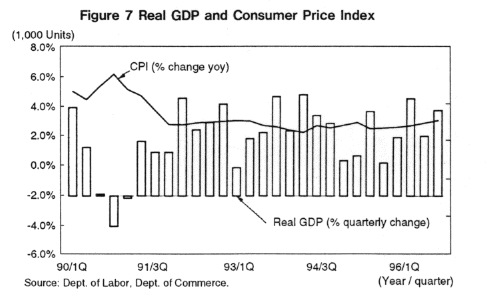
We revised our previous outlook, which held that the adjustment phase would continue in the first half of 1997, followed by a moderate recovery in the second half.
The U.S. economy is expected to maintain its present growth pace in 1997, rising slightly from 2.4% in 1996 to 2.7%, with 2.6% growth in the first half and 2.4% in the second half. As employment continues to expand strongly, rising incomes will cause consumer spending to continue expanding. The constraint on consumption posed by mounting consumer loans is abating as employment expands and new loans are restrained. Capital investment, while not as strong as in 1996, is firm in undertone and will support the economy's growth. In addition, inventory adjustments are near completion against the backdrop of strong final demand, indicating that production will begin rising. Due to steady domestic demand, net exports will be a drag on the economy as automobile imports rise sharply. However, the economy will slow by the end of 1997 against a backdrop of rising interest rates and other factors. Inflation will rise moderately through the end of 1997 as the labor market continues to tighten.
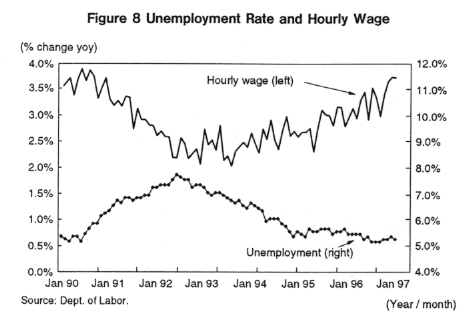
In monetary policy, we predict an additional interest rate hike by the end of September to bring the FF rate to 6% and discount rate to 5.5%. Since excessive tightening could derail the economy, the possibility of large interest rate hikes is small.
(2) Europe
Against the backdrop of a weaker DM, Germany is in transition from an export-led recovery to one fueled by expanding domestic demand. The U.K. is in an acceleration phase led by consumption as the sterling remains strong.
1) Germany
As a result of the strong DM in 1995, the economy posted two consecutive quarter-on-quarter declines from the fourth quarter of 1995. But exports then gained strength as the DM weakened. From the end of 1996 to early 1997, cold weather temporarily brought economic activity to a standstill, but production resumed growth as the weather recovered.
We predict Germany's growth rate to rise from 1.4% in 1996 to 2.3% in 1997. External demand will continue to be steady, while domestic demand will be somewhat sluggish as companies are pessimistic toward increasing employment and making new investments.
Although the weaker DM is being reflected in input prices, we predict that prices will remain stable due to moderate wage increases and sluggish domestic demand. Inflation in the cost of living index will remain at approximately 2% in 1997.
The official discount rate and Lombard rate (presently 2.5% and 4.5%) will most likely not be raised during 1997 because of weak domestic inflationary pressures and the nervousness of financial markets pending membership in the single currency.
n2) U.K.
Consumer spending will continue to drive the U.K. economy against a backdrop of expanding employment and rising incomes. We predict that the economy's growth rate will rise from 2.1% in 1996 to 3.1% in 1997. The temporary income increase from the income tax cut and restructuring of financial institutions is expected to amount to 4% of disposable income in 1997, and will be a powerful support to consumption. Strong domestic demand is expected to spur the expansion of corporate investment, which has lagged behind.
Price increases have been subdued as the sterling has appreciated due to capital inflows against a backdrop of the strong economy, high interest rates, and uncertainty surrounding the European Monetary Union. However, we predict that prices will rise 3% by yearend as the effect of the strong sterling abates and demand-side inflationary pressures mount.
The policy interest rate, presently at 6.0%, is likely to be raised to 6.5% after the May general election, and to 7.0% in the second half. While the Labor party is expected to return to power after 18 years of Conservative rule, we do not expect a major policy shift in economic policies. Any turmoil in financial markets will be short in duration.
(3) Asia
The real GDP growth rate of East Asia (China, NIEs, and ASEAN) will decline to 7.6% (estimate) in 1996 and 7.4% in 1997, in part due to slower export growth.
Export growth, which has supported East Asia's high economic growth over the past few years, declined in 1996 due to (1) the worldwide semiconductor market slump, and (2) reduced competitiveness due partly to the weaker yen.
In 1997, while Korea and ASEAN economies will continue slowing down, China will pick up due partly to its gradual monetary easing during 1996.
China − As a result of monetary easing during 1996, including the reduction of deposit and loan rates at financial institutions, the real growth rate will rise to 10.3% in 1997 (from 9.7% in 1996), and inflation will also edge up.
Korea − Korea's real growth rate will decline to 5.8% in 1997 (from 7.1% estimated for 1996) due to: (1) slower export growth, and (2) the effect of labor strikes opposing labor law reforms. Inflation will remain at the same level as in the previous year.
Taiwan − The economy had been heading toward recovery in early 1997 due in part to monetary easing during 1996 including official discount rate cuts. But the ban on pork exports due to possible contamination will dampen the real growth rate to 5.8% in 1997 (compared to 5.7% in 1996), while inflation will trend upward.
Hong Kong − While an undertone of instability will persist until the reversion to China is completed, the expansion of domestic demand-including construction of the new airport-will cause the real growth rate to reach 4.9% (compared to 4.7% estimated for 1996). Inflation will tend to rise slightly.
Singapore − The economy will continue to slow during the first half of1997, but will improve in the second half as export growth increases, and post a real growth rate of 6.5% for 1997 overall (compared to 7.0% in 1996). Inflation will remain stable.
4. Exchange Rates
(1) Present Status
− Sensitivity to Economic Conditions in Japan and the U.S.
Since entering 1996, the yen/dollar rate has been sensitive to interest rates and economic conditions in Japan and the U.S. Yen upswings in February, April, and July were triggered by expectations of monetary tightening in Japan. The yen weakened from last summer after the August 28 BoJ Tankan survey reduced expectations of higher interest rates and the economic outlook of the U.S. improved.
Furthermore, since fiscal tightening was announced in mid December, the dollar surged against the yen from the mid ¥110 range to the mid ¥120 range, reflecting opposing outlooks for Japan and the U.S.-a bleaker outlook and plunging stock prices in Japan, and steadiness in the U.S.
More recently, the Berlin G7 meeting (February 8, 1997) punctuated a strong message from monetary authorities to financial markets that the strong dollar would no longer be encouraged, causing price corrections in the New York Stock Exchange. While the weak yen/strong dollar situation was temporarily alleviated, divergent economic outlooks for Japan and the U.S. suggest that the yen is still subject to weakness.
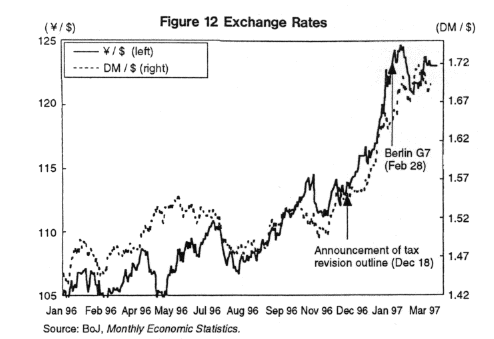
(2) Forecast
− Pressure for Weaker Yen to Remain for the Time Being
The stronger dollar following the Berlin G7 statement will abate somewhat. In fact, since the 1985 Plaza Accord, reversals in the yen/dollar rate have often coincided with shifts in G7 exchange rate policies.
However, while the Berlin G7 statement expressed caution about a stronger dollar, no agreement was made on bringing down the dollar. Moreover, with concern that fiscal tightening may derail Japan's economy and unresolved problems with Japan's financial system, there will continue to be little upward pressure on the yen.
For the time being, the exchange rate will fluctuate in the ¥115-125 range based on economic conditions in Japan and the U.S. In mid 1997 or the fall, as Japan's external surplus gradually expands and signs of economic recovery are confirmed, the yen will strengthen moderately. We predict the average exchange rate to be ¥114 for fiscal 1997.
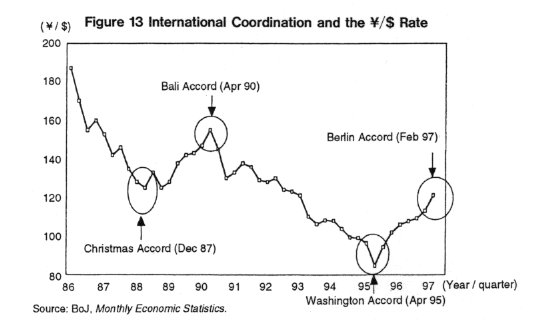
the Economic Research Dept.
Research field
レポート紹介
-
研究領域
-
経済
-
金融・為替
-
資産運用・資産形成
-
年金
-
社会保障制度
-
保険
-
不動産
-
経営・ビジネス
-
暮らし
-
ジェロントロジー(高齢社会総合研究)
-
医療・介護・健康・ヘルスケア
-
政策提言
-
-
注目テーマ・キーワード
-
統計・指標・重要イベント
-
媒体
- アクセスランキング

















